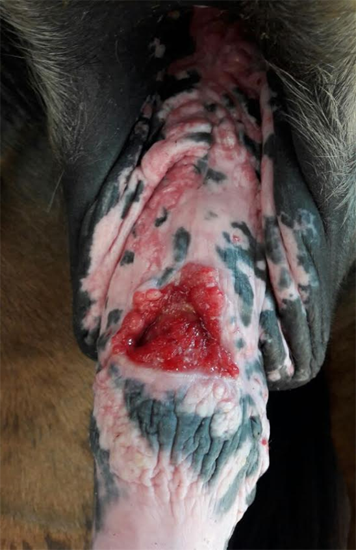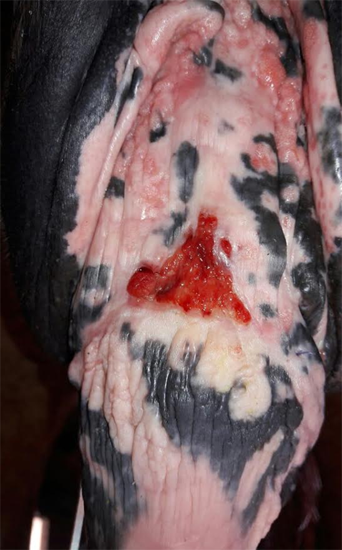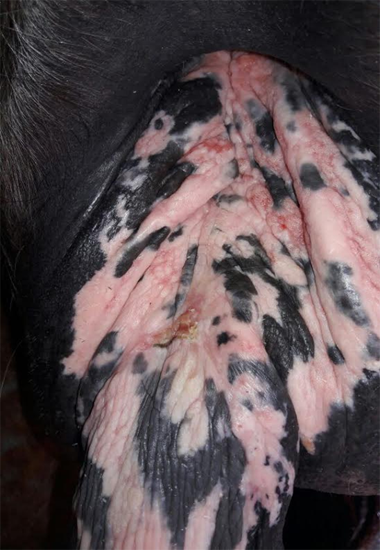Case Report
Volume 1 Issue 5 - 2017
Evaluation of a Topical Natural Product Formulation with Cantharanthus rosea and Cynodon dactylon for the Treatment of Squamous Cell Carcinoma in a Gelding. A Case Study.
1Mines Pet Medicare Sdn. Bhd. CG-34, Blok C Seri Pulai, Taman Balakong Jaya, 43200 Kajang, SEL.D.E
2Hoof and Paw (M) Sdn.Bhd. No 5, JALAN TPS 2/12, Taman Pelangi Semenyih 2, 43500 Semenyih, SEL.D.E
2Hoof and Paw (M) Sdn.Bhd. No 5, JALAN TPS 2/12, Taman Pelangi Semenyih 2, 43500 Semenyih, SEL.D.E
*Corresponding Author: Shankar Ganesh K, Mines Pet Medicare Sdn. Bhd. CG-34, Blok C Seri Pulai, Taman Balakong Jaya, 43200
Kajang, SEL.D.E
Received: December 12, 2017; Published: December 18, 2017
Abstract
A 20 years old gelding suffering from a 10months of relapsing squamous cell carcinoma (SCC) on the penile sheath was treated with a natural remedy as surgical intervention was not successful. A daily application of herbal ointment healed the ulcer within 21 days. No relapse of ulcer was observed 3 Months post heal.
Keywords: Squamous cell carcinoma; Natural product therapy
Introduction
The allopathic chemotherapy practices for tumor treatment in veterinary and medical treatment has been exposing patients to severe general systemic toxicity instead of selective cytotoxicity of cancer cells. Therefore, a natural product formulation according to Siddha practice was adopted to evaluate selected herbs known to be efficacious against tumor in human to be applied on a squamous cell carcinoma ulcer in a gelding.
Squamous cell carcinoma (SCC) refers to a malignant neoplasm of the epithelium lining the internal and external lining of the body, accounting to 80 to 90 percent of all cancers in the veterinary and medical field. Epithelial tissue is found throughout the body such as in the skin and lining of organs and internal passageways such as gastrointestinal tract. Carcinomas are divided into two major subtypes, namely adenocarcinoma which develops in an organ or gland are capable of secretion such the mammary gland that produce milk and other organs such as colon, prostate and lung that secrets mucus. Another type is SCC which originates in the squamous epithelium.
Materials and Methods
A gelding suffering from a chronic SCC was diagnosed with tissue samples taken from the ulcerative and non-healing wound masses and confirmed as SCC by laboratory diagnosis.
The gelding was subjected to a natural therapy after 3 surgeries on the SCC failed to halt the remission on the same spot on penile sheath. Despite four intralesion injection of cisplatin, at one week interval to halt remission, failed as the SCC was resistant to the drug. Therefore, further surgical intervention was stopped, as repeated anaesthesia of a senile horse is not recommended. A topical application that covers the entire SCC ulcer was carried out daily.
Selected herbs harvested locally was washed, cleaned, cut into small pieces and dried in shed before it is crushed into small pieces. Among the important ones are Catharanthus rosea (Shohel., et al. 2014, Kabesh., et al. 2015 and Joyce., et.al. 2011) and Cynodon dactylon (Janani., et al. 2011). The exact formula is not revealed for copyright purposes.
Catharanthus rosea known as Nityakalyaani in Tamil, a Siddha medicine, is an Indian origin herb, finds its use in cancer treatment very long before chemical chemotherapeutics came into practice. The plant, apart from its anti-cancer activity, exerts anti-bacterial activity (Kabesh., et al. 2015), which may have contributed synergistically to the control of pus forming bacteria, in our successful SCC treatment.
Cynodon dactylon or known as Arugampul in Tamil, has been a healing agent in Siddha medicine, thousands of years, mainly as blood purifier. Blood purification is a very general term being claimed, to purify biological system, without specific site of action. Therefore, the herb awaits a scientific study to specify its action. A few compound in this grass is known to have anti-cancer activities (Janani., et al. 2011). These mixed herbs was then heated up with sesame oil to absorb active ingredients. The medicated oil was then bottled and applied on ulcerating SCC for possible healing effects.
Results
The progress in the healing SCC ulcer is illustrated in the following figures.
The cost and efficacy of surgical and cisplatin injection for 4 weeks has failed to cease remission. Therefore, the cost and efficacy of the current natural therapy is compared to cisplatin treatment in Table 1.
| SCC treatment for an adult gelding | Cisplatin treatment (Intrelesion Injection) | Natural Therapy |
| Cost/week(RM) | 150.00 | 50.00 |
| Total cost for 4 weeks | 600.00 | 200.00* |
| Drug Resistance | Present | Not present |
| Remarks | Healing achieved in 21 days and no remission for 3 months post healing till euthanasia. |
Table 1: Comparison of cost between chemotherapy and natural therapy for SCC treatment.
*The cost if treatment continued for 4 weeks. The current natural therapy cured SCC in 3 weeks.
*The cost if treatment continued for 4 weeks. The current natural therapy cured SCC in 3 weeks.
Discussion
The decision to initiate chemotherapy was difficult as the horse is senile and the side effect may be severe with vincristine or cisplastin. The relapsing SCC has been completely cured without remission for 3 months post heal. These results shows that, natural remedy could be applied topically without any tissue and systemic toxicity in compromised and senile patient safely. These finding paves the way for the development of biopharmaceuticals from natural product, in veterinary and medical chemotherapy.
However, current success on topical cancer treatment is limited, as systemic malignancies could not be treated albeit metastasis in carcinomas are rare. Therefore, with extensive research and development, the bio active compounds has to be identified; to formulate intramuscular of intravenous chemotherapeutic drugs. A molecular biological research is vital to identify the mechanism of action of each herbal extract and its compounds separately.
The ultimate aim of this study is to develop natural anti-cancer compounds by validating the effect on animals; to be extrapolated for application on biotechnological research for biopharmaceuticals development to cure mankind from dreaded malignancies. Cervical carcinoma (CC) is a type of SCC that affects women globally to result in death in severe cases (Priscilla., et al 2015). The current topical application could be validated for the intracervical application on women detected with CC at early stage without having to undergo toxic chemotherapy.
Certain alkaloids such as vincristine from the plant Catharanthus rosea has been proven to exert cytotoxic and anti-neoplastic activity in cell line, in vitro as well as in vivo in animals and humans. However, the cytotoxicity of alkaloids are very severe that it causes general systemic toxicity and could be administered intravenously by veterinary and medical professionals with caution. On the contrary, the current natural product could be used without much side effects and it was observed to be superior to cisplatin, whereby healing was achieved in just 21 days without remission and drug resistance.
The discovery of novel compounds currently has to undergo a lengthy procedure of etchical, safety, clinical trial and global authorities such as Food and Drug Authority (FDA) that may cost billions for approval of one anti-cancer or any other drug (Daniel and Norman, 2000). For example, thousands of chemically synthesized drugs are tested for more than ten years; to eventually obtain only one drug approval from FDA is not a viable effort.
The tedious scenario could be totally avoided in natural product drug discoveries; by identifying evidence based; efficacious ethnomedicine herbs; to be subjected to direct bio active compound extraction and identification. Therefore, tropical countries should formulate their own systems of drug discovery and approval without the involvement of FDA; hence minimising the cost and time to unveil bio active compounds in tropical herbage, yet to be identified; at a faster pace. As funding is always a constraint for the ethical and safety procedures, government funding and favourable drug discovery policies has to be established.
Many scientific studies has been done to prove the efficacy of bio-active compounds, namely the secondary metabolites, such as the alkaloids, terpenoids, flavanoids, saponins and others as anti-neoplastic with other bio- activities (Simeon., et al. 2015). However, the availability of these compounds may vary in concentration; according to environmental stresses, therefore bioinformatics has to be established to identify quality and high concentration yielding tropical herbages, globally.
In conclusion, the medical and veterinary industry awaits a safer and efficacious chemotherapy to alleviate all side effects due to current chemically synthesized drugs; in addition, to minimize the cost of cancer treatment. The cost effectiveness of cancer treatment may extend the use of a drug in a wider range of animals, especially pet, and save them from euthanasia and chronic drug toxicity. The successful animal validation may pave the way for novel and safe drug discoveries for medical application.
References
- Shahel Hossain., et al. “Pytochemical screening of Catharanthus roseus and Ficus Racemosa leaves extract. A statistical inference”. International Journal of Bioassays 4.1 (2015): 3606-3610.
- Jananie RK., et al. “Determination of bioactive components of Cynodon dactylon by GC-MS Analysis”. New York Science Journal 4.4 (2011): 16-20.
- Kabesh K., et al. “Phytochemical analysis of Catharanthus roseus plant extract and its antimicrobial activity”. International Journal of Pure & Applied Bioscience 3.2 (2015): 162-172.
- Joyce Nirmala M., et al. “Natural plant resources in anti-cancer therapy”. Research in Plant Biology 1.3 (2011): 01-14.
- Priscilla AF., et al. “Cytotoxic effects of alkaloids on cervical carcinoma cell lines: a review”. Journal of Basic and Applied Pharamaceutical Sciences 36.3 (2015): 359-366.
- Daniel SF and Norman R.Farnsworth. “The values of plants used in traditional medicine for drug discovery”. Environ Health Perspect 109.1 (2001): 69-75.
- Simeon PCF., et al. “Bioactivity and therapeutic potential of plant extracts in cancer and infectious diseases”. Journal of Diseases and Medicinal Plants 1.1 (2015): 8-18.
Citation:
Shankar Ganesh K., et al. “Evaluation of a Topical Natural Product Formulation with Cantharanthus rosea and Cynodon
dactylon for the Treatment of Squamous Cell Carcinoma in a Gelding. A Case Study.”. Multidisciplinary Advances in Veterinary Science
1.5 (2017): 198-203.
Copyright: © 2017 Shankar Ganesh K., et al. This is an open-access article distributed under the terms of the Creative Commons Attribution License, which permits unrestricted use, distribution, and reproduction in any medium, provided the original author and source are credited.

































 Scientia Ricerca is licensed and content of this site is available under a Creative Commons Attribution 4.0 International License.
Scientia Ricerca is licensed and content of this site is available under a Creative Commons Attribution 4.0 International License.